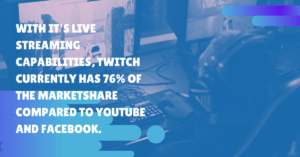
Influencer marketing is one of the most powerful strategies available to eCommerce brands today. That’s because the backbone of the practice is word-of-mouth–the most epic of drivers for business results.
As research from Twitter has shown, “…nearly 40% of Twitter users say they’ve made a purchase as a direct result of a Tweet from an influencer.” Additionally, a Sparkler study commissioned by Snap, Inc. found that 31 percent of consumers cited influencers as persuasive forces in buying decisions.
That makes influencer marketing a powerful tactic for driving more sales for eCommerce companies.
All of this illustrates the idea that eCommerce brands can generate huge wins by cultivating new customers and brand advocates through influencer marketing.
If your eCommerce company is ready to dive into the compelling world of influencer marketing, here are seven imperative steps to launching a lucrative campaign.
#1: Identify the Right Influencers

Simply Googling “eCommerce influencers” produces a plethora of results. That doesn’t mean that everyone is suited for your campaign efforts. Finding the right influencers that align with your brand and reach your target audience in resonant ways is the key to influencer marketing success.
Effectively pinpointing appropriate influencers is arguably the hardest part of the whole process. These folks need to fit well with your brand voice, campaign concept and engage your target demographic.
To uncover the right social stars, you are going to need to utilize influencer marketing tools and platforms like Sideqik as these provide a depth of information on each person’s audience statistics that you likely cannot obtain on your own
That said, if possible, you want to identify influencers who already love your brand. This creates a natural partnership with someone who supports your eCommerce business. Try searching across various social sites with hashtags or social listening tools to suss out influencers who are already brand advocates.
#2: Build a Strong Relationship

With your list of influencers in hand, begin reaching out. Influencer platforms like Sideqik make this process much easier, but if you are doing things the old-fashioned way, start by liking, commenting and sharing their posts. After you have added to their social conversations over several weeks, message them to introduce your brand, its unique selling points and the value it provides to consumers.
Without the ability to gain an influencer’s attention and show them why your product is not only useful but superior, your campaign may be dead before it launches.
#3: Pitch Your Campaign
After spending some time connecting with potential influencers (or reaching out to them through a dedicated platform), pitch them your campaign idea. But before doing so, make sure you know what you want.
Are you running a contest? Do you want product reviews? What type of content do you want to produce (images, videos, etc.)? What demographics are you targeting?
Product reviews are a great option for eCommerce brands. A Tubular Insights study uncovered that 64 percent of consumers were driven to buy after watching a branded influencer video. This is because influencers became prominent through cultivating credibility, and 84 percent of consumers trust online reviews as much as a friend’s recommendation.
No matter what campaign concept you pitch, allow influencers as much creative freedom as possible. Their audience loves the content they create. Don’t stifle that by limiting their voice and originality. The idea is to be collaborative, not authoritative.
A prime example of this is Tarte Cosmetics’ #TrippinWithTarte campaign that utilized beauty influencers to share images and vlogs within their normal content scheme. Tammy Hembrow–one of the influencers they partnered with–took a trip to the Hayman Islands with the brand’s products, subsequently generating 1.4 million views for herself and the company.
Finally, while some micro influencers are likely to be content with free products for participating, it is best to provide influencers monetary compensation because this shows that you are invested in their content and value their efforts.
Generating videos can be a lot of work, so be sure to pay these folks what they’re worth.
#4: Create Unique Content and Experiences
While collaborating with influencers, seek to identify creative campaign concepts that generate an experience for consumers. But again, don’t be controlling. Let the influencers do what they do best.
One of the best interactive experiences you can offer is a giveaway or contest because it makes the audience a part of the campaign. This is an incredibly engaging technique.
The Body Shop did just this, and with style. The company aimed to promote its Fuji Green Tea product line in Belgium. Partnering with the country’s local influencers, the brand leveraged social authorities to promote awareness by compelling fans to share their wellness habits with the hashtag #HealthyMoment. The contest ultimately reached 225,000 individuals, generated 50,000 likes and increased engagement by 22 percent.
#5: Provide Influencer Support
While the influencers are tasked with the heavy lifting, your brand still needs to support their efforts by engaging the audience in the post’s comments and sharing their creations through your company pages.
This will help to spread the word about the campaign while simultaneously providing valuable social proof to those who follow but have yet to buy.
#6: Ensure Compliance
You need to be aware of FTC laws and endorsement guidelines for the type of campaign you are conducting and the locations you are targeting. Make sure to abide by the law of the land to keep everything above board.
In most cases, you simply need to make public the nature of the content by using appropriate labeling like #sponsored, #ad or having influencers state that, “…this video is sponsored by XX.”
Always ensure you have researched the legalities around your campaign before launching.
#7: Analyze Outcomes

Influencer campaigns are just the beginning to long and prosperous relationships that you engage in time and again.
For that reason, you need to analyze the effectiveness of each influencer using custom links, unique checkout codes or tracking pixels along with other metrics like impressions, engagement and the like.
This will let you know whom you want to form a lasting relationship and who might not be the best fit for your brand. This is vital info to have to ensure the success of future campaigns.
eCommerce sales are booming right alongside influencer marketing, particularly as more traditional strategies become less effective over time. When competing against the likes of Walmart and Amazon, your brand needs the means to compete, and influencers provide just that.
Employ these seven steps when launching an influencer-driven campaign and you can measurably boost your awareness and revenue through the credible and engaging voices of today’s social superstars.
 Article by Ron Dod. Ron is the Chief Marketing Officer and Co-Founder of Visiture. He is supported by a team of creative geniuses that strive to help clients achieve new levels of success. His passion is helping eCommerce business owners and marketing professionals navigate the search marketing landscape and use data to make more effective decisions to drive new traffic and conversions. Follow me @Visiture_Search
Article by Ron Dod. Ron is the Chief Marketing Officer and Co-Founder of Visiture. He is supported by a team of creative geniuses that strive to help clients achieve new levels of success. His passion is helping eCommerce business owners and marketing professionals navigate the search marketing landscape and use data to make more effective decisions to drive new traffic and conversions. Follow me @Visiture_Search






